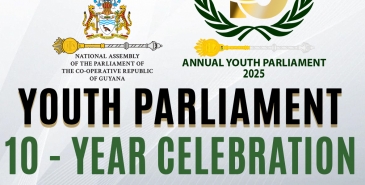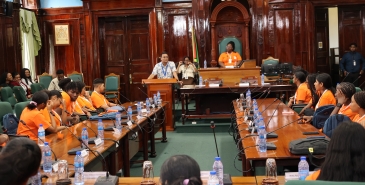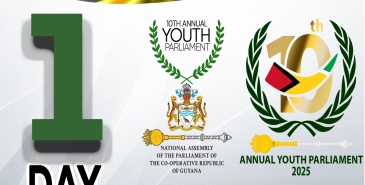Budget Speech Mr Christopher Jones- 2012
Speech delivered at: 11th Sitting - Tenth Parliament - 16 April, 2012
16 April, 2012
7441
April 16, 2012
Mr. Jones: I rise to make my contribution to the Budget 2012. But before I do this, Comrade Speaker, permit me to just note a statement by the Hon. Minister of Education as it relates to the teachers. She said: “We love the teachers and thank you.” She also said: “Teachers are the backbone of the nation.” Of course, no one will dispute that, but when the teachers, and by extension the public servants, can go to the marketplace and say to the vendor, “I love you; give me some groceries”, then the Opposition will be silent.
I turn my attention to the Budget 2012, presented under the theme, “Remaining on Course, United in Purpose, Prosperity for All”. The theme for this budget seems to suggest that despite the burdens of a sixteen per cent Value Added Tax, high levels of unemployment, discrimination, corruption, high rates of school dropouts and a high crime rate, this Government intends to remain on that course.
“United in Purpose”: Given the composition of this Tenth Parliament, one would have believed that the Government would have grasped the opportunity to ensure that all of the political parties represented in this House play a meaningful role in the putting together of this Budget 2012. This did not happen. So much for “United in Purpose”
“Prosperity For All”: In analysing the Budget 2012, it provides great difficulties for one to see where or to whom this prosperity goes. Certainly, it is not the pensioners; it is not those receiving public assistance; it is not the members of the police force, the army, the nurses or the teachers. It is prosperity, for whom?
It would be remiss of me not to iterate a statement issued on December 12, 2011 by then presidential candidate of APNU, now leader of the majority, the Hon. David Granger. The statement read, and I quote:
“Brigadier David Granger has issued an urgent call for the establishment of a tripartite budget committee. The call comes before the convening of the 10th Parliament, expected to take place later this year.
Mr. Granger also stated in the same statement:
“The proposed tripartite budget committee be convened as early as possible to oversee the preparation of the budget (and subsequent budgets). This committee will, among other things:
• collaborate with the Bank of Guyana, Guyana National Bureau of Statistics and other departments in presenting an accurate and detailed picture of the economy;
• identify all sources of funds and examine potential sources of new funds;
• propose tax reform measures, including the lowering of VAT and personal income tax, with their likely impact on revenue and economic growth.”
Article 13 of Guyana’s Constitution affords citizens and their organisations opportunities to participate in the management and decision making processes of the state. This basic right this Government has failed to grant.
We saw on November 28, 2011 that over one hundred seventy thousand Guyanese have placed their confidence in a new dispensation - fresh ideas, an end to the ayes have it and an end to business as usual, and not in the incumbent. As such there is the absolute need for meaningful consultation with all stakeholders, especially young people who will ultimately be the beneficiaries of all programmes and policies implemented by this or any Government.
In his Budget 2012 presentation, to this esteemed House, the Hon. Minister of Finance, under the caption “Youth”, stated, and I quote:
“…over 2,900 out of school youths and other vulnerable young people were trained under the National Training Programme for Youth Empowerment (NTPYE), the Board of Industrial Training (BIT), and the Youth Entrepreneurial Skills Training (YEST) Programme.”
Training of young people must be applauded, however it should be noted that it is the responsibility of the Government to ensure that the nation has a well trained cadre of youth, equipped with the necessary skills and knowledge to function effectively in the workforce. Since that matter has been cleared the questions which loom large are: Where are these youths employed and where are the jobs for those who will be trained in 2012? Was there a detailed study done to ascertain whether the training given is relevant to the current job market or even if jobs are readily available for the new trainees? Training persons is commendable, but it must be complemented with the creation of job opportunities. If this Government is serious about empowerment of young people it would formulate policies and programmes that can address this issue in a real way.
We were told by the Hon. Minister of Finance that some four hundred jobs will be created this year. Has the Government noted that in 2011 there were approximately five thousand five hundred graduates from the University of Guyana, five hundred and forty-five from the Government Technical Institute (GTI), four hundred and sixty-one from Cyril Potter College of Education (CPCE), one hundred and thirty-four from Guyana Industrial Training Centre (GITC), and seventy-eight out of the Carnegie School of Home Economics (CSHE)? It is some six thousand seven hundred and eighteen from just five institutions coupled with the two thousand nine hundred from the various training programmes as highlighted by the Hon. Minister of Finance, a figure of nine thousand six hundred and eighteen. This represents but a small fraction of persons placed on the job market every year. I am sure that the Minister of Labour is aware of the number of people leaving these learning institutions yearly. Unfortunately, what we see there is the unwillingness by the Government to confront the question of the country’s growing unemployed population. The International Labour Organization (ILO) stated, and I quote:
“…‘young people are more than three times as likely as adults to be out of work.’ Open unemployment is however the tip of the iceberg – the ILO estimates that an additional three hundred million plus youth can be categorised as ‘working poor’, meaning that they are living below the US$2 a day poverty line, despite working. These youths are often forced to work in deplorable conditions, for meager pay, trapped in the limitations of the informal economy.”
So I echo my own sentiments that it is commendable for the Government to train its youths in various fields, but after that, what is next? Where are the jobs?
One does not need a microscope to see the coherence of certain fallacies presented in the Budget 2012 as in the 2011.To bring clarity to this statement let me first focus on an excerpt of the Budget 2012. The Hon. Minister of Finance, in his budget presentation, said, and I quote:
“Mr. Speaker, the past year has witnessed significant developments in the area of sports infrastructure. In 2011, the National Aquatic Centre at Liliendaal was opened, along with our country’s first public squash courts at Racquet Centre in Georgetown.”
The Hon. Minister of Finance also told this House that a sum of $675 million has been earmarked for continuation of the athletic track at Leonora, among other sporting facilities. When one notes that over the years Guyana’s best athletes came from Regions 10, 5 and 4, the question that arises is: Why the track is being built in Region 3? In a country of some eighty-three thousand square miles it is quite regrettable to note that the development of sports, and in extension youth, has been limited, whether deliberately or by share coincidence, to a small fraction of the country. Should not the allocation and utilisation of the country’s resources be for the development of all?
The Hon. Minister of Culture, Youth and Sport Dr. Frank Anthony, in his Budget 2011 presentation, alluded to the efforts made by his Government to develop sports and sporting infrastructure in Guyana. He said, and I quote:
“…ten multi-purpose centres that the Government is establishing in schoolyards across the various regions; it is also the ten multi-purpose tarmacs that the Government has established in various communities. This year will be adding to all of that because Government has set aside $200 million to be spent in communities across this country. Therefore there will be approximately 200 grounds in various communities that will benefit from small grants. ”
I must bring this House’s attention to the Hon. Minister of Culture, Youth and Sport’s Budget 2012 presentation in which he stated that Government has set aside $180 million, this year, for the rehabilitation of grounds, therefore communities can benefit from small grants. The question has to be asked: Where is the $200 million, as the Hon. Member pointed out, that was allocated to the rehabilitation of communities grounds, last year? But I would not go in-depth with that, because on Wednesday this House will resolve itself into Committee and, of course, we in the APNU stated that we will be going through these Estimates page by page, line by line and the Hon. Member will have to account for the $200 million. I must add, with a fine-tooth comb.
The Hon. Minister did not, at that time, name those communities, but we were told that some $200 million of the taxpayers’ dollars would be spent. Upon investigation, it is impossible for one to locate those multi-purpose centres. It is my fervent request that the Hon. Member would indicate to this House the exact geographic location of those centres, of which I am sure others, as myself, are eager to have a tour. One also hopes that the Hon. Member can furnish this House with the specificity as to those communities which were beneficiaries of those grants as well as an overall assessment of the said project and the criteria used.
In his presentation on the Budget 2011, former Member of this House, Mr. Steve Ninvalle named several communities in which development was poised to take off. He indicated, and I quote:
“The basketball arena has not gone unnoticed by this Government. Plans are afoot to put in basketball facilities at municipal market tarmacs in several areas so that youths can participate in meaningful activities when there is no market. The areas earmarked for this development are Diamond, Enmore, Bath/Waterloo, Buxton, Pouderoyen, De Willem, Charity, Plaisance and Patentia”.
My investigation has revealed that there is no basketball facility at any of the named areas. To use the words of the Hon. Member, now Attorney General, it was just fluff.
There is the saying “a picture tells a thousand words”, so I now present to this Hon. House, the evidence, or to quote the Hon. Member Mr. Rohee, I now present the “ee-vidence”. Diamond market tarmac, fluff.
Hon. Members (Opposition): Fluff.
Mr. Jones: Enmore market tarmac, fluff.
Hon. Members (Opposition): Fluff.
Mr. Jones: Bath/Waterloo, fluff.
Hon. Members (Opposition): Fluff.
Mr. Jones: Buxton.
Hon. Members (Opposition): Fluff.
Mr. Jones: Pouderoyen.
Hon. Members (Opposition): Fluff.
Mr. Jones: DeWillem.
Hon. Members (Opposition): Fluff.
Mr. Jones: Charity.
Hon. Members (Opposition): Fluff.
Mr. Jones: Lusignan.
Hon. Members (Opposition): Fluff.
Mr. Jones: Plaisance.
Hon. Members (Opposition): Fluff.
Mr. Jones: And Patentia.
Hon. Members (Opposition): More fluff.
Mr. Jones: Fluffy.
Mr. Speaker: Could you send those up as exhibits so I could observe them later on?
Mr. Jones: Sure Cde. Speaker. I will do so. Where has the money gone? Where has the hard work for taxpayers’ money gone? The Hon. Member must account.
As a representative of youth, I must registered in this Tenth Parliament our disgust, dissatisfaction and disappointment with the Minister of Culture, Youth and Sport, having been in office for a number of years and to date this country does not have a youth policy. The Hon. Minister should hang his head in shame and do the honourable thing. I am of the opinion that no serious studies have been done in the preparation for the earmarking of developmental projects in the area of sports. Rather it seems as though projects are proposed and done without consulting stakeholders, in addition to being done in a willy-nilly manner. I am also of the opinion that if politics is taken out of sports and a genuine multi-stakeholders forum is held it will not only serve well for the development of sport but it will also provide a holistic approach or policy for youth development.
In taking an analytical look at the facts before this noble House, one can from his or her own opinion on whether there has been equity in the distribution of the country’s resources and to whom, and for what purposes these resources have been used. One has to see sports as critical to the developmental thrust of youth and therefore resources must be put into sports for it to be successful in the long term. There is the need for sports to be better organised in schools. There is the need for training of coaches for basketball, football, cricket and the other sporting disciplines. There should be a nexus with schools and sports. To quote Mr. Ollie Cooperwood, an assistant wrestling coach of the West Carteret High School, in the United States of America, on the importance of sports in the life of a young student, he stated:
“The importance of sports in the life of a young student is invaluable and goes much further than the basic answer that ‘it keeps kids off the streets.’ It does in fact keep kids off the streets, but it also instills lessons that are essential in the life of a student athlete. Sports play a pivotal role in the makeup of a young athlete, especially in the middle school to high school years where student athletes are much more mature and mentally developed. Where else can a young, impressionable youth learn values like discipline, responsibility, self confidence, sacrifice, and accountability.”
Mr. Kofi Annan, former Secretary General of the United Nations, stated and I quote:
“Young people should be at the forefront of global change and innovation. Empowered, they can be key agents for development and peace. If, however, they are left on society’s margins, all of us will be impoverished. Let us ensure that all young people have every opportunity to participate fully in the lives of their societies”
I take this opportunity to remind this noble House that it is the responsibility of those in positions of authority, public trust, to cater for and take care of the needs of the youth of Guyana. Let us aspire to join forces to work on policies and programmes to aid in the development of all Guyanese. For the future of this country, and her citizens, transcends beyond political differences, racial or other barriers. The life of each citizen of the Cooperative Republic of Guyana is impacted by each decision that we make in this esteemed House.
There is also the need for sports to be handed back to the Guyana Teacher’s Union.
So with that, Comrade Speaker, let the words of one of our favourite national songs bring new meaning to us. Join me as I ask you to “let us resolve to fight together. See we do it right, together.” Comrades of this Tenth Parliament, can we do it?
Hon. Members (Opposition): Yes, we can.
Mr. Jones: I thank you. [Applause]
Speech delivered by:
What's New

17 August, 2025
10th Annual Youth Parliament Closes: Celebrating a Decade of Impact, Excellence, and Youth Empowerment10th Annual Youth Parliament Closes: Celebrating a Decade of Impact, Excellence, and Youth Empower

13 August, 2025
Youth Parliamentarians Assemble for Grand Rehearsals for the 10th Annual Youth Parliament

12 August, 2025
10th Annual Youth Parliament Kicks Off – Young Voices, Bold Ideas, Bright Futures!

11 August, 2025
10th Annual Parliament Kicks off tomorrow

